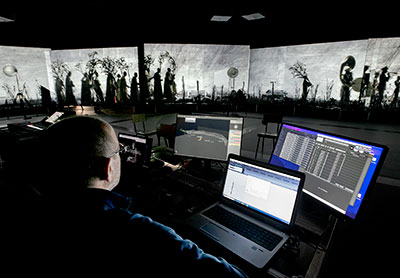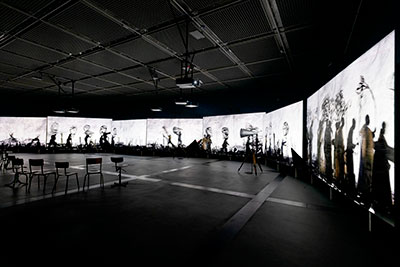![]() Amadeus has collaborated with South African artist, performer and director William Kentridge on an immersive sound environment for his latest multi-sensory installation, More Sweetly Play the Dance, at France’s Les Champs Libres centre.
Amadeus has collaborated with South African artist, performer and director William Kentridge on an immersive sound environment for his latest multi-sensory installation, More Sweetly Play the Dance, at France’s Les Champs Libres centre.
The exhibition evokes the concept of celebration in its broadest sense, as ‘a place to rejoice, resist, make a claim for social, identity and cultural rights, and catharsis – a place where spectacular and intimate meet’.
The installation envelops spectators in a seemingly endless parade of characters using a 35-long frieze of moving images and accompanying sound that, according to its author, draws visitors into a macabre dance while providing the opportunity to reflect on notions of injustice and inhumanity.
‘I am interested in political art, meaning: an art of ambiguity, contradiction, unfinished gestures, and random outcomes’, Kentridge says. ‘An art – and a politics – in which optimism is restrained and nihilism kept at bay. The film itself is part of a series of projects that deal with despair in this era of disappearing utopias.’
 A procession of anonymous human-sized silhouettes walk, dance, stagger and wander across the room, from one screen to another, in front of a devastated landscape, scratched and dirtied with Kentridge’s Indian ink. The parade includes a brass band, dancers, miners, animated objects and politicians. Shadows and mysteries are also explored through the ghosts of South Africa’s troubled past.
A procession of anonymous human-sized silhouettes walk, dance, stagger and wander across the room, from one screen to another, in front of a devastated landscape, scratched and dirtied with Kentridge’s Indian ink. The parade includes a brass band, dancers, miners, animated objects and politicians. Shadows and mysteries are also explored through the ghosts of South Africa’s troubled past.
‘Les Champs Libres are among the first French institutions – notably the Théâtre National de Chaillot, the Comédie Française, or even La Scala – to believe in the artistic and perceptive added value that the new spatialisation-linked sound technologies could provide,’ explains Champs Libres Head of Audiovisual and Digital exhibitions, Olivier Le Du. ‘As such, in 2016 our auditorium was equipped with an advanced immersive and sound localisation system, built around the Holophonix spatialisation processor developed by the Amadeus company. Given the artistic depth of William Kentridge’s work, its immersive character both visually and sonically, it seemed obvious to us, in consultation with the creators, to evolve the sound creation towards a dynamic, object-oriented approach.’
‘We wanted to go beyond a stereophonic left/right approach, by bringing this work into a totally spatial dimension where the sounds would be in movement, following the silhouettes of this macabre dance, arising in front, behind, and above the spectators, with nuances, reliefs,’ Le Du adds.
‘From our first thoughts about the programming of More Sweetly Play the Dance, we felt it was relevant to use a spatial system,’ says Champs Libres General Manager, Dewi Seignard. ‘However, we could not deprive our auditorium of its Holophonix processor for several weeks. We were also aware of a development project at Amadeus, concerning a software version of the Holophonix solution for the macOS platform, which we were able to preview and even suggest various ergonomic improvements for the software app.’
Convinced of the value of these new technologies, the Champs Libres team proposed a new electro-acoustic and technological device to Kentridge’s team, who showed great interest and agreed to rework the sound dimension of this work. Gavan Eckhart, Kentridge’s sound designer, and sound engineer travelled to Rennes from South Africa to work with Dewi Seignard for a week.
‘The original sound diffusion system was based on a ten-loudspeaker set-up, including four cone-shaped acoustic horns, mainly used to play ambient sounds. The audio mix consisted of five stereophonic tracks integrated within the eight video files played in the exhibition,’ Seignard says.
 ‘Based on the new Holophonix Native sound spatialisation software and 22 loudspeakers – including 16 Amadeus PMX 5 point-source loudspeakers installed on two levels, four Amadeus ML 12 subs, and four acoustic horns – the new electro-acoustic configuration created more possibilities for presenting the original sound recordings to imagine a three-dimensional mix, totally object-oriented. The system allowed us to synchronise the sound materials as the procession progressed, only when needed, because the correlation between the image and the sound is not automatic in the artistic proposal.’
‘Based on the new Holophonix Native sound spatialisation software and 22 loudspeakers – including 16 Amadeus PMX 5 point-source loudspeakers installed on two levels, four Amadeus ML 12 subs, and four acoustic horns – the new electro-acoustic configuration created more possibilities for presenting the original sound recordings to imagine a three-dimensional mix, totally object-oriented. The system allowed us to synchronise the sound materials as the procession progressed, only when needed, because the correlation between the image and the sound is not automatic in the artistic proposal.’
‘We had to respect the purpose of the parade, to adapt to movements that are not completely linear, and to keep a delicate balance between the different sources. Gavan was very satisfied with the result.’
After listening to the different spatialisation algorithms available in the Holophonix Native solution, Eckhart first chose an amplitude-based panning algorithm called LBAP (Layer-Based Amplitude Panning) for the processing of the main system, and, second, a stereo panning algorithm for the spatialisation of the four acoustic horns.
LBAP is an amplitude-based panning algorithm, optimised for 3D devices with multiple layers that do not necessarily all have the same number of loudspeakers.
‘We used the Reaper DAW software to play and mix the audio tracks and control the automation linked to the sound objects,’ Seignard says. ‘The various movements and motions linked to the sources were written and played back in OSC (Open Sound Control) thanks to the HoloScore plug-in. The final mix was recorded to a Cymatic Audio UTrack24 player/recorder. These 22 tracks were then imported into QLab software running on a Mac Mini, providing playback during the operational phase.’
The entire installation is based on the AES67 protocol, including virtual soundcards, amplifiers and AD/DA converters. ‘The video sequences are projected using eight Barco G60-W laser light source projectors,’ Le Du says. ‘Seven projectors are equipped with 0.75/0.95:1 focal lengths. One projector is equipped with a 0.95/1.22:1 focal length. The synchronisation of the video and audio tracks is ensured by a Crestron Electronics automation system.’
This collaboration will be part of future exhibitions by Kentridge ‘We were so impressed with the results that we unanimously decided – in particular with video designer Rembrandt Boswijk – that future installations of this work will be processed with Holophonix,’ concludes Kentridge’s sound designer and engineer Gavan Eckhart. ‘The integration of this new technology into our production flow was almost seamless and extremely pleasant to deal with. The result takes this piece to another level of immersion and emotional realism.’
More: http://amadeuslab.com